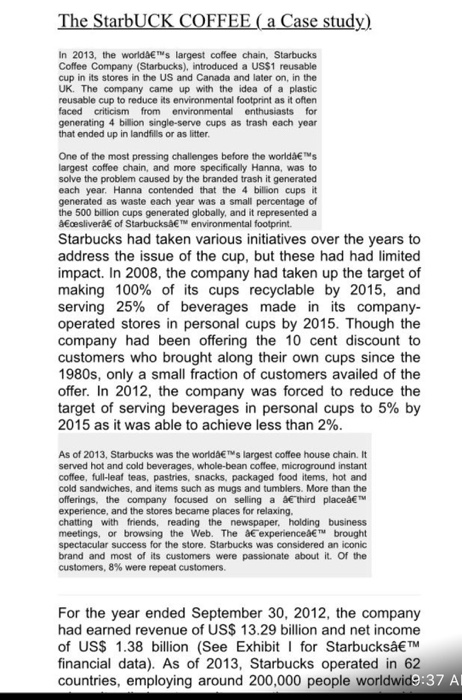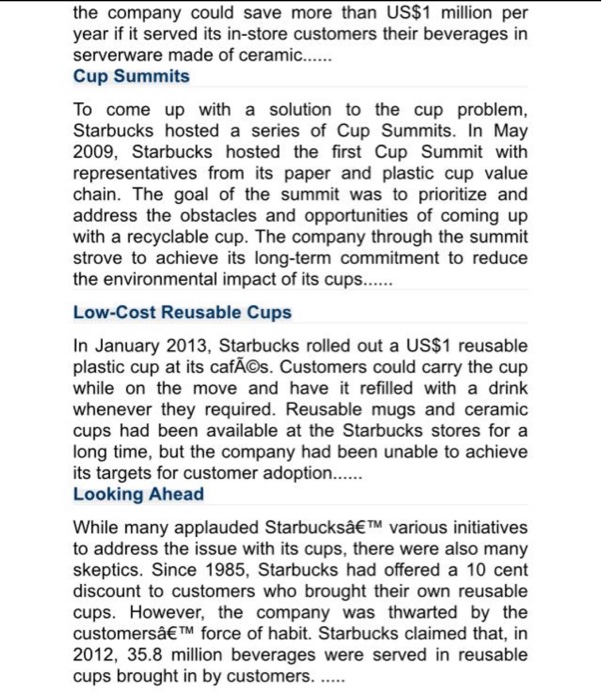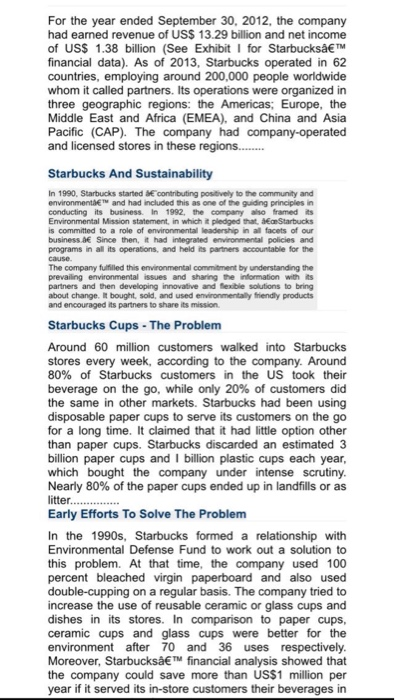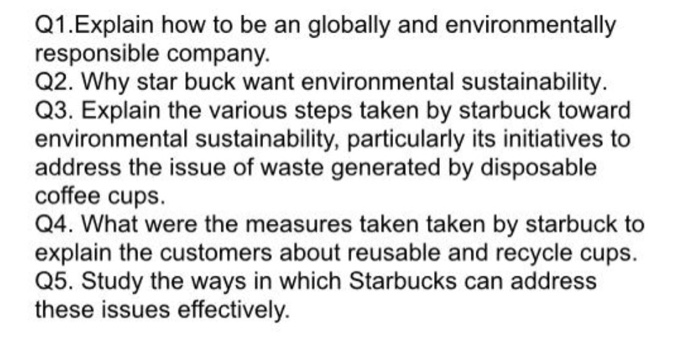The StarbUCK COFFEE ( a Case study). In 2013, the world 's largest coffee chain, Starbucks Coffee Company (Starbucks), introduced a US$1 reusable cup in its stores in the US and Canada and later on, in the UK. The company came up with the idea of a plastic reusable cup to reduce its environmental footprint as it often faced criticism from environmental enthusiasts for generating 4 billion single-serve cups as trash each year that ended up in landfills or as litter. One of the most pressing challenges before the world 's largest coffee chain, and more specifically Hanna, was to solve the problem caused by the branded trash it generated each year. Hanna contended that the 4 billion cups it generated as waste each year was a small percentage of the 500 billion cups generated globally, and it represented a aceslivera of Starbucks environmental footprint. Starbucks had taken various initiatives over the years to address the issue of the cup, but these had had limited impact. In 2008, the company had taken up the target of serving 25% of beverages made in its company- operated stores in personal cups by 2015. Though the company had been offering the 10 cent discount to customers who brought along their own cups since the 1980s, only a small fraction of customers availed of the offer. In 2012, the company was forced to reduce the target of serving beverages in personal cups to 5% by 2015 as it was able to achieve less than 2%. As of 2013, Starbucks was the world 's largest coffee house chain. It served hot and cold beverages, whole-bean coffee, microground instant coffee, full-leaf teas, pastries, snacks, packaged food items, hot and cold sandwiches, and items such as mugs and tumblers. More than the offerings, the company focused on selling a third placeae experience, and the stores became places for relaxing. chatting with friends, reading the newspaper, holding business meetings, or browsing the Web. The 8 experienced brought spectacular success for the store. Starbucks was considered an iconic brand and most of its customers were passionate about it. Of the customers, 8% were repeat customers. For the year ended September 30, 2012, the company had earned revenue of US$ 13.29 billion and net income of US$ 1.38 billion (See Exhibit I for StarbucksTM financial data). As of 2013, Starbucks operated in 62 countries, employing around 200,000 people worldwid9:37 A For the year ended September 30, 2012, the company had earned revenue of US$ 13.29 billion and net income of US$ 1.38 billion (See Exhibit I for StarbucksTM financial data). As of 2013, Starbucks operated in 62 countries, employing around 200,000 people worldwide whom it called partners. Its operations were organized in three geographic regions: the Americas; Europe, the Middle East and Africa (EMEA), and China and Asia Pacific (CAP). The company had company-operated and licensed stores in these regions....... Starbucks And Sustainability In 1990, Starbucks started M contributing positively to the community and environment and had included this as one of the guiding principles in conducting its business. In 1992, the company also framed its Environmental Mission statement, in which it pledged that Starbucks is committed to a role of environmental leadership in all facets of our business. Since then, it had integrated environmental policies and programs in all its operations, and held its partners accountable for the cause The company fulfilled this environmental commitment by understanding the prevailing environmental issues and sharing the information with its partners and then developing innovative and exible solutions to bring about change. It bought, sold, and used environmentally friendly products and encouraged its partners to share its mission Starbucks Cups - The Problem Around 60 million customers walked into Starbucks stores every week, according to the company. Around 80% of Starbucks customers in the US took their beverage on the go, while only 20% of customers did the same in other markets. Starbucks had been using disposable paper cups to serve its customers on the go for a long time. It claimed that it had little option other than paper cups. Starbucks discarded an estimated 3 billion paper cups and I billion plastic cups each year, which bought the company under intense scrutiny. Nearly 80% of the paper cups ended up in landfills or as litter... Early Efforts To Solve The Problem In the 1990s, Starbucks formed a relationship with Environmental Defense Fund to work out a solution to this problem. At that time, the company used 100 percent bleached virgin paperboard and also used double-cupping on a regular basis. The company tried to increase the use of reusable ceramic or glass cups and dishes in its stores. In comparison to paper cups, ceramic cups and glass cups were better for the environment after 70 and 36 uses respectively. Moreover, Starbucks financial analysis showed that the company could save more than US$1 million per year if it served its in-store customers their beverages in Q1.Explain how to be an globally and environmentally responsible company. Q2. Why star buck want environmental sustainability. Q3. Explain the various steps taken by starbuck toward environmental sustainability, particularly its initiatives to address the issue of waste generated by disposable coffee cups. Q4. What were the measures taken taken by starbuck to explain the customers about reusable and recycle cups. Q5. Study the ways in which Starbucks can address these issues effectively










